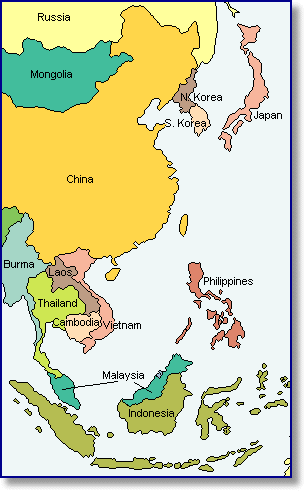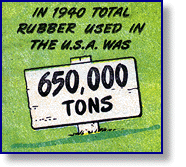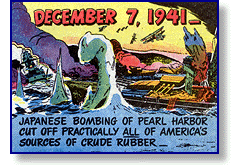 Destination eastern Asia:
Destination eastern Asia:
The Rubber Crisis
< Back | Main menu | PSLC
Our next stop in the rubber expedition is Japan, and the year is 1941. Why are we here? We're here because one of the biggest drawbacks of owning something valuable is that someone else is always trying to steal it. That is the problem our rubber growers in southeast Asia are facing right now.
The Uncertain Rubber Supply
For the past few decades, a lot of people in the world have been unhappy about the southeast Asian rubber monopoly. The German armed forces were not thrilled about the monopoly during World War I when a British naval blockade kept them from getting any rubber. It had become hard to fight a war without rubber. Trucks needed tires, engines needed gaskets, so on and so forth. During and after that war a lot of people in a lot of countries started to feel uneasy that not only their military strength but their industrial and economic strength were dependent on foreign rubber.
 Rubber has come a long way since the days of Charles Goodyear. The world is completely
dependent on it. Every machine from automobiles to radios has at least some rubber parts.
In a lot of countries scientists are hard at work trying to come up with synthetic rubber. But
in one industrialized country less healthy ways of securing a rubber supply are being plotted.
Rubber has come a long way since the days of Charles Goodyear. The world is completely
dependent on it. Every machine from automobiles to radios has at least some rubber parts.
In a lot of countries scientists are hard at work trying to come up with synthetic rubber. But
in one industrialized country less healthy ways of securing a rubber supply are being plotted.
Stealing the Source
That country is Japan. The Japanese war machine has been wreaking havoc in eastern Asia since 1931. All this aggression has made it hungry for rubber. The Japanese plan for securing its rubber supply is very simple: send a big army to southeast Asia and take over the rubber fields. And that's just what they do. Most of the rubber plantations were in the Dutch East Indies, (which would become Indonesia), and British Malaya (which would become Malaysia). On December 8, 1941, the Japanese invade Malaya, and they take Singapore two months later.
 This plan not only secures Japan a rubber supply, but cuts off the supply of rubber to all its
enemies. And Japan has lots of enemies by this point. Japan has attacked China, British and
French colonies in southeast Asia, and Australia. And as if they don't have enough enemies,
they attack the United States at Pearl Harbor, the day before invading Malaya: December 7, 1941.
This plan not only secures Japan a rubber supply, but cuts off the supply of rubber to all its
enemies. And Japan has lots of enemies by this point. Japan has attacked China, British and
French colonies in southeast Asia, and Australia. And as if they don't have enough enemies,
they attack the United States at Pearl Harbor, the day before invading Malaya: December 7, 1941.
This isn't a very smart thing to do, needless to say. Attacking a country with nearly unlimited natural resources, two large oceans protecting it, and a strong national desire to be left alone is never a winning proposition. But there is one natural resource the United States doesn't have. That is rubber of course, whose main sources the Japanese now control.
Another Source
But that's not where the story ends. Remember how scientists in a lot of countries have been trying hard to make synthetic rubber? Wouldn't you know it, a lot of them are succeeding.The quest for synthetic rubber began near the birthplace of natural rubber.
-
Go to Brazil: Sweet Beginnings
If you want to continue on into the future and see how the United States Government responds to the Japanese attack . . .
-
Go to Washington D.C.: Government Rubber
Meanwhile...
While Japanese armies are conquering southeast Asia, this is going on in the rest of the world:
-
1938: Off the coast of Madagascar, a live coelacanth is caught. Until now, the fish has been
thought to be extinct for millions of years.
1940: In the United States, Richard Wright publishes his novel Native Son, which offers a painful examination of racial attitudes and injustice.
1940: In Europe, German armies conquer France, while Britain resists a severe German air bombing campaign in a fight known as the Battle of Britain.
For more information, at other websites...
-
Wartime Giants - learn more about the wartime development of synthetic
rubber, part of Polymers and People from the Chemical Heritage Foundation.
Image credit
-
In 1940, total rubber used...: From Wonder Book of Rubber, 1947, copyrighted
material of The BFGoodrich Company reproduced with the permission of The BFGoodrich Company.
December 7, 1941: From Wonder Book of Rubber, 1947, copyrighted material of The BFGoodrich Company reproduced with the permission of The BFGoodrich Company.
Polymer Science Learning Center and the Chemical Heritage Foundation
